Ridge Racer is a racing video game series developed and published for arcade systems and home game consoles by Bandai Namco Entertainment, formerly Namco. The first game, Ridge Racer (1993), was originally released in arcades for the Namco System 22 hardware, later ported to the PlayStation two years later as a launch title. It was met with several sequels and spin-off games for multiple platforms, the latest being the mobile game Ridge Racer Draw & Drift (2016) with the latest mainline game being Ridge Racer 7 (2006). Gameplay involves the player racing against computer-controlled opponents to be the first to finish in a race. Drifting is a core aspect of the series, and is used to keep speed while turning corners.

Ridge Racer 64 is a racing video game developed by Nintendo Software Technology for the Nintendo 64 in 2000. It features a total of 20 race tracks, including some drawn from Ridge Racer and Ridge Racer Revolution.

Automobili Lamborghini is a 1997 racing video game developed and published by Titus Software for the Nintendo 64. It is a successor to Lamborghini American Challenge.

Moto Racer, mislabeled as Moto Racer Gold, is an arcade style motorcycle racing game developed by Delphine Software International and published by Electronic Arts for Microsoft Windows and PlayStation. The game was originally to be published by BMG Interactive, but after BMG closed down its U.S. operations it sold the publication rights to Electronic Arts. Critics hailed the game as the first outstanding arcade-style racer to appear on PC, and the PlayStation version in turn was called a strong conversion in reviews.

R4: Ridge Racer Type 4 is a racing video game developed and published by Namco for the PlayStation. It is the fourth title in the Ridge Racer series after Rage Racer and the last to be released for the PlayStation. It was released on December 3, 1998 in Japan and further released the following year in Europe and North America. It was later re-released on the PlayStation Network in 2011, again in 2023 for PlayStation 4 and PlayStation 5, and pre-loaded on the PlayStation Classic which was released on December 3, 2018. It is the first Ridge Racer series game on the PlayStation to use Gouraud shading on polygons and was followed by Ridge Racer V in 2000.

The NeGcon, stylized as neGcon, is a motion-based game controller manufactured in 1995 by Namco for the PlayStation. One of the first third-party peripherals for the system, the controller is connected by a swivel joint, allowing the player to twist the halves relative to each other. The controller also replaces the "symbol" buttons on the original PlayStation controller with two "A" and "B" buttons, as well as "I" and "II" buttons that allowed for analogue control. A black variant was released exclusively in Japan.
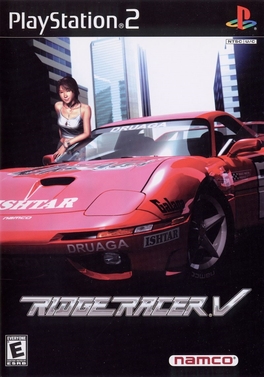
Ridge Racer V is a 2000 racing game developed and published by Namco for the PlayStation 2, as a launch game for that platform. It is the fifth title of the Ridge Racer series succeeding Ridge Racer Type 4 and was followed by Ridge Racer 6 in 2005. The game received a home-to-arcade port named Ridge Racer V: Arcade Battle.
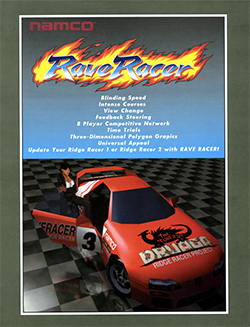
Rave Racer is an arcade racing game that was released by Namco in 1995. It runs on Namco System 22 hardware, and could be played by two people per cabinet for up to eight players total when up to four of them were linked together. It is the third arcade title in the Ridge Racer series and the follow-up to Ridge Racer and Ridge Racer 2.

Ridge Racer 6 is a racing game by Namco released in 2005. It was the sixth console game in the Ridge Racer series but unlike the previous mainline entries, which were released for PlayStation consoles, this entry was released exclusively as a launch title for the Xbox 360. In a similar fashion to the first Ridge Racer on PS1, Ridge Racer V on PlayStation 2, Ridge Racer(s) on PlayStation Portable and eventually Ridge Racer 7 on PlayStation 3. All are exclusive launch titles for their respective consoles.

Ridge Racer 7 is a racing video game developed by Namco Bandai Games for the PlayStation 3. It was released in Japan and North America by Namco Bandai Games in 2006 and PAL territories by Sony Computer Entertainment in 2007. The seventh mainline installment in the Ridge Racer series, it was developed as a launch title for the console. The game has around 40 cars, many of which return from Ridge Racer 6 and the PSP incarnations of the game. There are also 22 courses, available in forward, reverse and mirror mode. The game runs at 1080p native resolution and 60 frames per second. It also features Dolby Digital 5.1 surround sound and free online gameplay via the PlayStation Network.

Ridge Racer, released in Japan as Ridge Racers, is an arcade racing video game developed by Namco for the PlayStation Portable. It is named after the eponymous Ridge Racer video game series to which it belongs. The game was released in Japan on 12 December 2004, in North America on 24 March 2005, and in Europe and Australia on 1 September as a launch title. Available in the game is a fully playable version of the Namco arcade game New Rally-X.

Ridge Racer is a 1993 racing video game developed and published by Namco. It was released initially on the Namco System 22 arcade system board and ported to the PlayStation console in 1994. It is the first title in the Ridge Racer series released for arcades and home consoles.

Monaco Grand Prix: Racing Simulation 2, also known as just Monaco Grand Prix, is a Formula one racing game developed and published by Ubisoft for Microsoft Windows, Nintendo 64, PlayStation, and Dreamcast. It was released in 1998-1999. A sequel, Racing Simulation 3, was released in 2002.

Ridge Racer 2, released in Japan as Ridge Racers 2, is an arcade-style racing game developed by Namco Bandai Games for the PlayStation Portable hand-held console, marking the 14th release in the Ridge Racer series and also the sequel to the PSP launch title Ridge Racer. It saw release in Japan on 14 September 2006, followed by its 13 October European launch and 19 October release in Australia. The original North American release was cancelled. On 20 December 2022, Ridge Racer 2 was made available worldwide to download on PlayStation 4 and PlayStation 5 as part of the PlayStation Plus Premium subscription service.

Rapid Racer, known as Turbo Prop Racing in North America, is a racing video game developed by SCE Studios Soho and published by Sony Computer Entertainment exclusively for the PlayStation. In the game, the player takes control of a motorboat and races around six different tracks. Eventually, all six tracks can be raced mirrored, as well as set at night time.
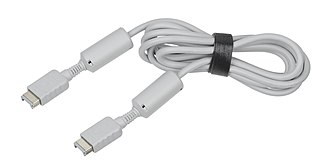
The PlayStation Link Cable (SCPH-1040) is a peripheral cable for the PlayStation console. Utilizing the serial I/O port found on the back of most PlayStation models, it allows for two consoles to be connected in order to play compatible multiplayer games on separate consoles. It was released during the 1995 Christmas shopping season.
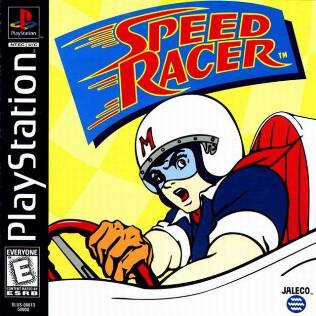
Speed Racer, known in Japan as Mach Go Go Go, is a PlayStation game based on the television show of the same name. It was released by the company Jaleco in 1996, though it did not appear in North America until March 27, 1998. It met with overwhelmingly negative reviews which cited simplistic and outdated gameplay and graphics.

Speed Racer is a arcade racing game designed by Namco based on the popular Japanese anime Speed Racer. The standard cabinet was a two-player, sit-down model.
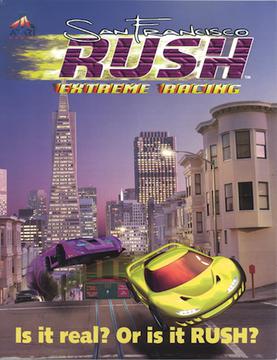
San Francisco Rush: Extreme Racing is a video game developed and published by Atari Games. This game was first released in arcades in 1996 and was ported to Nintendo 64 in 1997 and the PlayStation in 1998. San Francisco Rush: Extreme Racing is the first game in the Rush series.

Ridge Racer Accelerated for iOS, SoftBank 006SH with 3D screen and Amazon Kindle Fire Tablet on Android is an arcade racing video game developed by Namco Networks. It is part of the Ridge Racer video game series. The game was released on the App Store, Google Play and Amazon App Store and it uses micro-transactions for unlocking more courses and an extra car class. There are three cars available per class, with six cars more to be unlocked during the game's progress. The game also features an SP1 class consisting of prototype cars. The game features an Arcade, Duel, Survival and Time Attack mode. The game uses the same engine, race courses and menu system from Ridge Racer 2 (PSP).




















